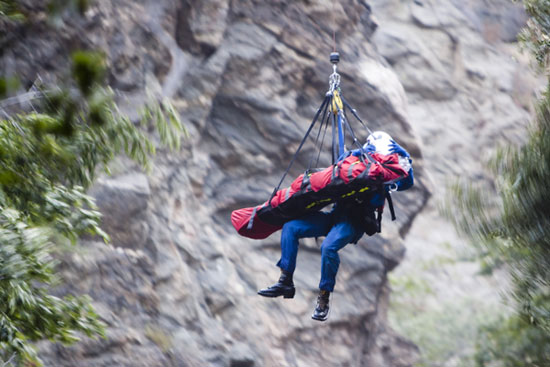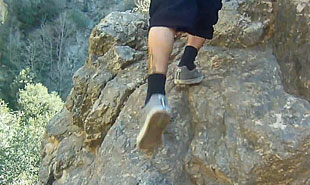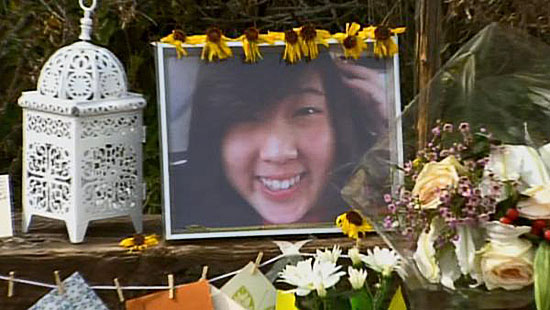Fatal attraction at the falls
May 2, 2013

Five people have died in the upper reaches of Eaton Canyon in the past two years, including this man in 2011.
It was late in the day when several twentysomething hikers happened upon veteran Los Angeles County rescuer Richard De Leon. Next to him was another young man, whose broken body had just been retrieved from the rocky floor of Eaton Canyon.
“Where you coming from?” De Leon asked the group, knowing all too well the answer.
“The second falls,” they confirmed. “But we’re fine.”
De Leon motioned to the man now being photographed by coroner’s officials. “So was he about an hour ago.”
The hikers assured De Leon they weren’t like that guy. “We know what we’re doing,” they insisted.
“So did he,” the rescuer said, hoping to drive home his point but knowing that he might as well have been lecturing the rocks.
Every day in the mountains above Pasadena, this sense of youthful invincibility collides with a stretch of treacherous terrain that leads to a waterfall tucked into Eaton Canyon. Unlike an easy hike that starts at the county-operated nature center and ends at a lower waterfall, there’s no trail to speak of to reach the upper falls—just an obstacle course of crumbling rock, tree limbs and narrow ridgeline paths with sheer cliffs on both sides.
In just the past two years, five people have fallen to their deaths there, the most at any single site in the county’s sprawling recreational landscape. The most recent, in March, was a 17-year-old Alhambra girl, who was a standout in academics and athletics. Already accepted to Cornell and Massachusetts Institute of Technology, high school senior Esther Suen sustained fatal head injuries after she plunged 200 feet. A teenage companion also fell, but he survived.
Although the problem is not new, De Leon, who is team captain of the Sheriff’s Department’s search and rescue team in Altadena, says the frequency of people being stranded and injured is on the rise because of social media postings that draw inexperienced hikers to the place and the destruction of other Angeles National Forest trails from the massive Station Fire a few years back.
“By the second or third rescue of the day,” De Leon says, he gets frustrated with the risk takers. “I start thinking, ‘Will you people just stop!’ ”
How to get them to do that, however, has turned into a test of competing strategies and wills among the government agencies that share responsibility for the area, including L.A. County and the U.S. Forest Service, which is responsible for the wilderness land that hikers use to reach the second waterfall.
In 2011, a series of multi-jurisdictional meetings were convened that included representatives from Supervisor Michael D. Antonovich’s office, the county’s parks and sheriff’s departments and the Pasadena fire department. From that effort came an online public service announcement featuring four uniformed sheriff and fire officials, who stressed that getting to the second waterfall “isn’t worth losing your life.”
But many at the table had wanted more. Some in the law enforcement contingent wanted to start charging reckless hikers for the substantial costs of rescues. Others suggested fencing off access points. At a minimum, though, most everyone agreed that the forest service should post a strongly worded warning sign where hikers, who’d easily reached the first waterfall, begin the mile-long trek to the second one. That is, most everyone except the forest service.
Ranger Mike McIntyre, who oversees the area, told the group that forest service lawyers wanted no warning signs placed on the agency’s land, in a spot where there’s not even a trail. Doing so, he said, could open the forest service to legal liability; attorneys representing injured hikers might argue that, if agency officials knew there was a risk of injury, then they had an obligation to make the area safer.
Now, in the wake of Suen’s death, the group is headed back to the table, this time with an even greater urgency to push the forest service to act, especially with the busy summer season approaching—or, as the Los Angeles Daily News put it in a recent editorial calling for better signage and more patrols at Eaton, the “dying season.”
Said Sussy Nemer, a senior deputy to Antonovich, whose district includes Eaton Canyon: “We’d like to see all the county agencies and the City of Pasadena work with the forest service to increase the signage near the second waterfall and put in place some kind of physical barrier to prevent hikers from even getting up there.”
Nemer said her office also hopes to recruit the area’s new state and federal elected representatives, “who could serve as allies in our cause.”
Russ Guiney, the director of the Los Angeles County’s Department of Parks and Recreation, said he’s under no illusion that more warning signs or even a fence would end the risky adventurism that’s luring the mostly younger crowds to dangerous heights. But like the county’s warnings signs in the lower canyon, he said, it might stop some in their tracks, which would represent a significant contribution to life and limb.
“I think if I was the forest service, I would want to do more,” Guiney said. “I’d think we had a moral obligation. Certainly, we in the county feel that we have a moral obligation….What people deserve and expect is a fair warning.”
Guiney also said that his office would continue to monitor—and counter—such social media sites as YouTube and Yelp, where people have romanticized the second waterfall and downplayed the dangers.
Forest service ranger McIntyre said in an interview that, at the moment, he doesn’t foresee a shift in strategy from his agency. “We’re doing what our lawyers are telling us to do,” he said.
People mistakenly come to Eaton Canyon thinking it’s an urban park, along the lines of Griffith Park, he said. “But the forest is a wildlands area,” he said. “I’m not saying the forest is dangerous but it comes with inherent risks. We need to make people better prepared, and they need to know their limits.”
Michael Leum, who oversees all of the Sheriff’s Department’s search and rescue teams, says to count him among those who’d like to see the forest service take a more active role in Eaton’s safety issues and not treat them “like Kryptonite.” Since the forest service says it has no trails beyond the first waterfall, Leum said, “they believe there is no need for maintenance or signage, regardless of the fact that hundreds of people go up there.”
Leum said that if he had his way, he’d want the agency to “install safe ingress and egress into the area.”
The status quo, he said, only guarantees this: “People are going to get hurt and killed in that canyon.”
Posted 5/2/13














 405 bridge work causes a stink
405 bridge work causes a stink
